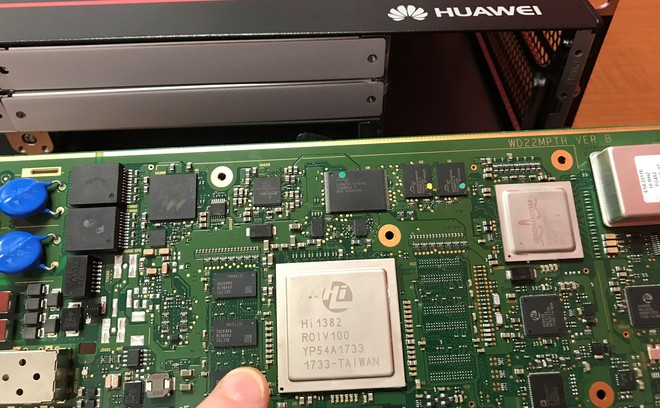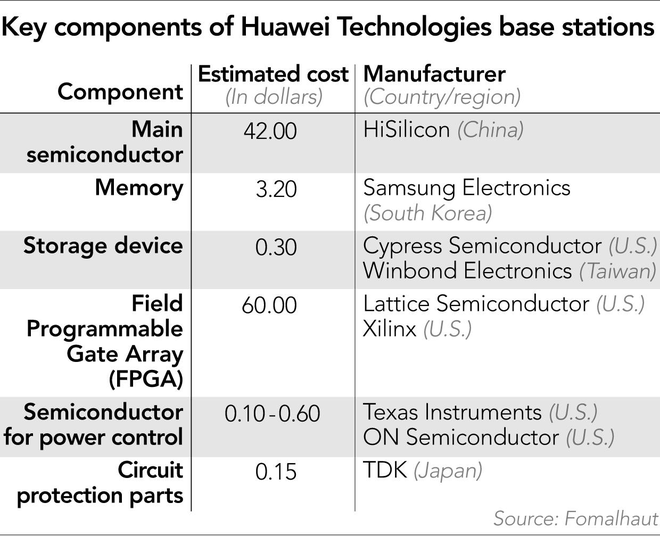Huawei has only ripped through the 5G base station to see how much Chinese companies need American parts
- Tram Ho
Not smartphones, the telecom infrastructure business is the most important area for Huawei as it is currently a leader in global market share. A significant competitive advantage Huawei owns many important technology components that can help them reduce costs as well as limit the impact of US government bans.
But when Nikkei magazine dissected a Huawei base station for 5G, they found that the US components in this critical device still accounted for 30% of the product value. Not only that, the central processing unit of this device is provided by a Taiwanese outsourcing company, which is under the jurisdiction of the new US Department of Commerce’s new export restriction regulations.

The chip for the 5G base station was designed by Huawei itself, but still requires TSMC to manufacture.
That said, Huawei is still having a hard time wanting full autonomy from foreign component suppliers, and how well its current production depends on remaining inventories.
What’s inside Huawei’s 5G base station
Huawei’s base station device measures 48cm x 34cm and is 9cm thick and weighs about 10kg. This device is typically located on the roof of buildings and processes audio signals to and from cell phones, as well as encoding radio signals for mobile communications equipment.
The 5G base station’s main processor is also the largest semiconductor piece on the board. Above the 5G base station’s main processor is the words “Hi 1382 TAIWAN”. The Hi, which stands for HiSilicon, shows that the chip was designed by Huawei’s semiconductor subsidiary. However, this chip is manufactured by TSMC, the world’s largest semiconductor outsourcing company today.
Although TSMC is not an American company, a significant portion of the equipment it uses to manufacture chips comes from the US, so under the new US Department of Commerce’s export restrictions, TSMC does not to be provided with chips to Huawei if they have not obtained a license. At the moment, the chipmaker said, they have also stopped supplying chips to Huawei.

Motherboard in Huawei 5G base station.
Digging deeper, Nikkei also found that FPGA array programming chips are also used in this 5G base station equipment from Huawei. These FPGA chips are also supplied by US companies including Lattic Semiconductor and Xilinx. These semiconductor chips are a matrix of pre-configured logic blocks that can be reprogrammed according to the desired applications and functions. In base station devices, these chips are used to update the internal telecommunications mode to the software to control.
There are also other semiconductor devices to control the energy source – a critical part of these base stations. They are provided by Texas Instruments and ON Semiconductor, US companies.
Other components from the US include memory chips from Cypress Semiconductor, Spansion, telecommunications chips from Broadcom and amplifiers from Analog Devices.
According to an executive at Fomalhaut Techno Solutions, the company dissected Huawei’s 5G base station, the circuit board of this device is filled with electronic components from Texas Instruments. ” Although there are also many important components supplied by Chinese companies, they make up less than 1% of the number of devices .” Therefore, according to Fomalhaut, this device ” still heavily depends on American components. ”

The origin of the most important components in Huawei’s 5G base station.
Estimated production cost for each of these devices is about $ 1,320, of which Chinese-made components account for about 48.2% of the value, relatively higher than the 41.8% rate on Mate 30 smartphones Huawei’s most advanced 5G equipment.
Besides a large proportion of US components, Korean components also account for the second largest share in this device. The majority of base station memory chips are supplied by Samsung Electronics. Japanese suppliers also contribute to this device with components from TDK, Seiko Epson and Nichicon.
Reliance on US components detracts Huawei’s price advantage
In the past, Huawei’s competitiveness was that it could offer up to 40% lower prices than rivals Nokia and Ericsson, but the US government’s order to limit the export of components took away this advantage. of a Chinese company. That’s also why Huawei has been rushing to stockpile US chips and other key components for more than a year before a new mid-year ban cut off its supplies entirely.

By the time Huawei was in decline, Samsung won a 5G network contract with Verizon.
When stockpiles run out, Huawei will face an inevitable decline and may even disrupt its plans to build 5G networks in some markets that Huawei is rolling out.
Not only did that make some carriers look to other providers, but it also led to the rise of smaller telecom equipment suppliers.
In early September, Samsung said it had won a contract to provide 5G telecommunications equipment worth $ 6.6 billion to Verizon in the US. NEC, a Japanese telecom equipment supplier, is also planning to expand the supply of base station equipment to Japanese carriers after it abandons Huawei equipment.
Most recently, a series of US technology firms such as Microsoft, AMD are gaining a reputation for participating in the telecommunications equipment market with huge deals to acquire the telecommunications business of Nokia or the famous chip company Xilinx. with FPGA chips for telecommunications equipment.
Check out the Nikkei Asian Review
Source : Genk
